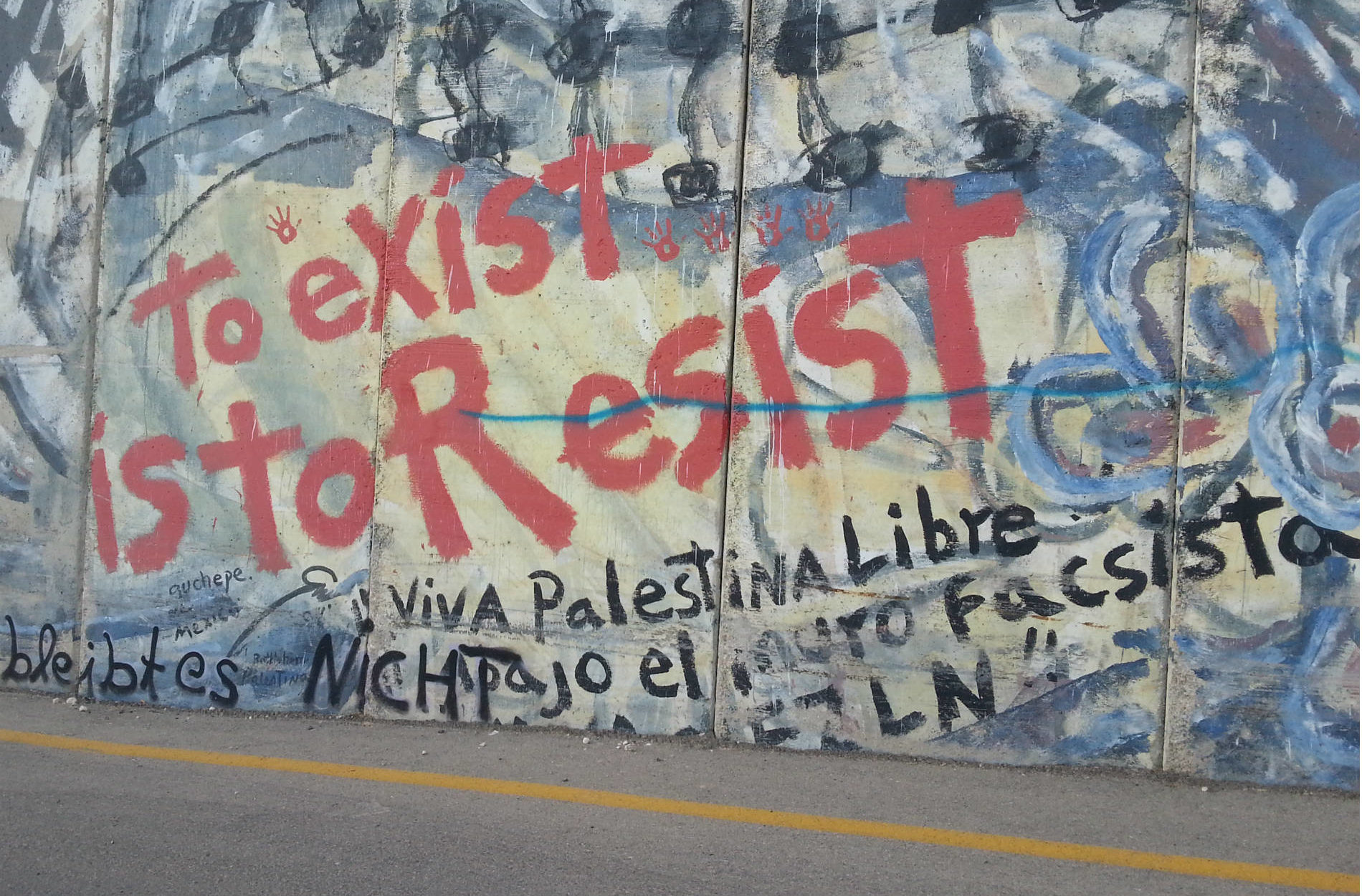Michaela lived in Bethlehem in the West Bank from January to April this year. She kept a journal of her experiences and encounters. Some names have been changed to protect identities.
A Palestinian father of four and a taxi driver who loves music, Omar is 48 years old. Each morning on his car radio he plays the music of Egyptian songstress Fairouz.
‘Here in Palestine Fairouz is played in the mornings,’ he says. But as soon as the news comes on the radio, the iconic diva is turned down and everything goes quiet. Omar avidly follows the recent round of peace talks before they crash and burn. In my three months in occupied Palestine, he is the only person I meet who takes notice.
Articulate, gentle and funny, Omar loves playing backgammon while smoking and drinking coffee. Prematurely grey hair and a face worn with lines of worry belie the years of struggle within one of the most notorious and ingrained conflicts in the world. While trying to plan the futures of his children, he has witnessed the bloodshed of two intifadas (Palestinian uprisings), and struggled under the control of a 47 year old military occupation.
For a country the size of Wales, an inordinate amount of books with a spectrum of narratives have been written about the Israeli/Palestinian conflict. Two decades of failed bilateral negotiations reached another stalemate recently. Both sides have victims but both sides are not equal and the strong occupies the weak. One side is a self defined military superpower, the other has a history of devastatingly violent attacks but no army, tanks, planes or military traditions.
Both sides have victims but both sides are not equal and the strong occupies the weak.
Omar is one of many Palestinians who has hoped that the momentous occasion of the meeting of leaders during the Oslo Accords in 1993 would be the beginning of a path towards an independent Palestinian state. Instead, he watches the land being carved up before his eyes into what looks like a Swiss cheese today. He has seen Palestinian cities (Areas A & B) becoming isolated islands surrounded by the separation barrier, checkpoints and Israeli settler only roads. Area C (62% of the West Bank) remains under full Israeli control. Key issues such as what would happen with refugees, settlements, water and Jerusalem were set aside at Oslo and remain on the back burner today.
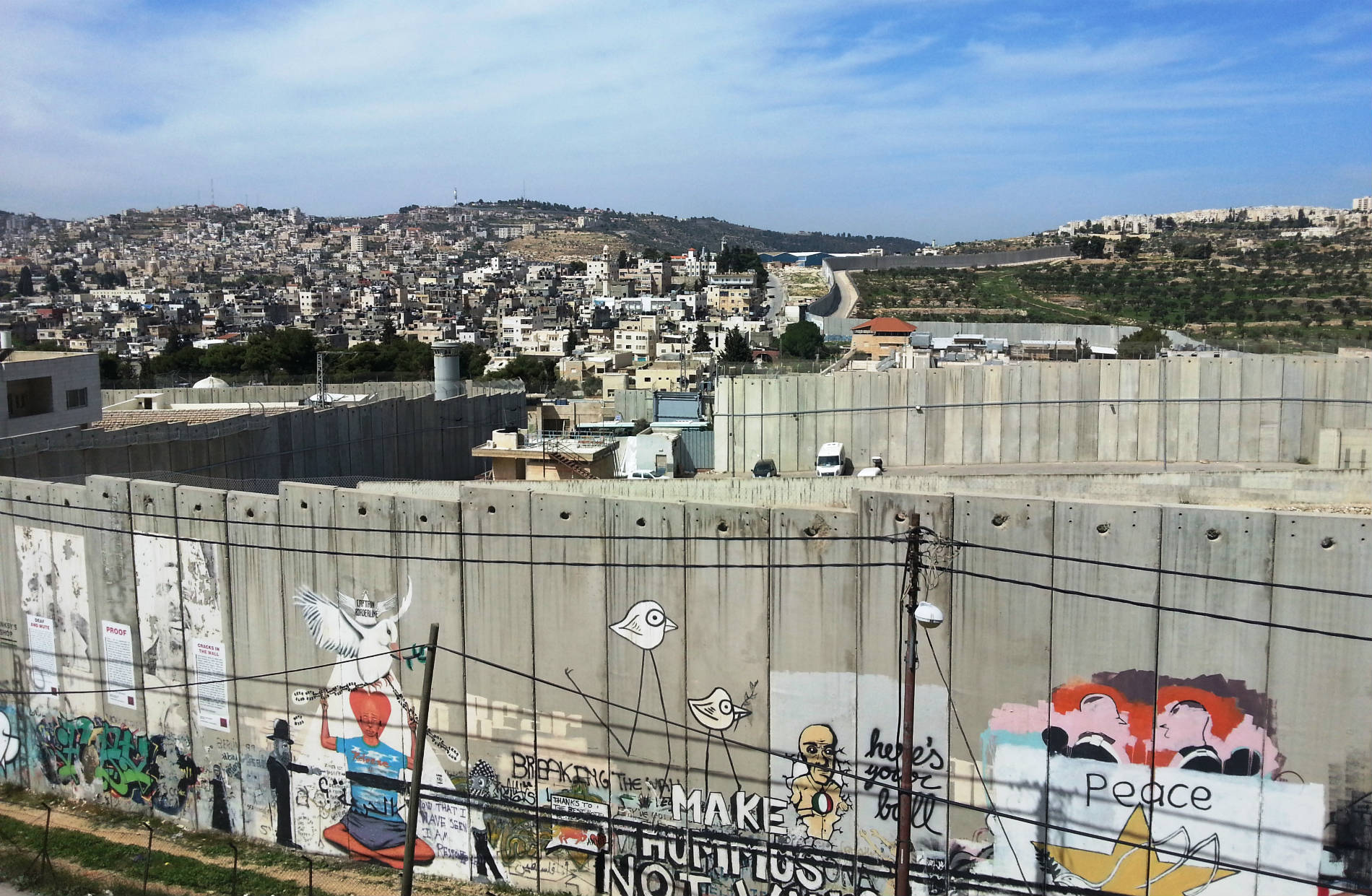
Wall in Bethlehem
After never experiencing life as a free man, Omar seems more prepared for compromise than many. His rarely encountered political optimism is born out of desperation for a solution and a belief that peace and coexistence for the two peoples are possible. His hopes are fading as fast as the facts on the ground are created as Israel continues to announce vast settlement expansion during the nine months of talks. In early April when Israel announces that they won’t be releasing the final group of Palestinian prisoners, the tit for tat breakdown in John Kerry’s personal project begins and Omar’s optimism crumbles.
‘If they can’t even agree onthis, what will happen when they begin to discuss Jerusalem?’ he says as his eyes darken with despair. ‘We have no future here you know.’
Adel is a Sheikh from the village of Al Jaba. The nearby town of Surif is where his extended family members live as well as being the nearest location for shops and health services. The access road to Surif has been closed off by the Israeli army by a large, yellow iron gate. The villagers can still walk there but they can’t drive.
Adel tells me, ‘I have a disabled son who cannot walk. We used to take him along to the next village for a massage, me, my wife and his brother. We all had a job, I would push him in the wheelchair, his brother would carry him over the roadblocks on his back and my wife would attend to his other needs. We used to do this twice a week but after some time, the doctor said to me, ‘He is not improving, what is wrong?’ I described the journey we had to take to get him there and he said, ‘Of course he is not getting better, you need to bring him in a car.’ This car will cost us 100 shekels each way. We cannot afford this so we no longer take him.’
On the tip of the tongue in occupied Palestine is always the question ‘Why?’
Due to movement restrictions placed on Palestinians, if Adel or Omar want to travel from Bethlehem to Ramallah they have to take a circuitous route through bumpy and dusty ‘Palestinian only’ roads so that a journey of 13 miles can take up to 2 hours. A route which should take 20 minutes via Jerusalem is not an option to the thousands of Palestinians who are not allowed to visit the city. Though the sacred place to the three largest Abrahamic faiths, Jerusalem is unreachable for thousands of Palestinians. They need permission to go there and this is rarely given. Only tourists, people with foreign passports, Israelis and Palestinians with Israeli ID cards or those difficult to obtain permits, are allowed to enter. It’s not unusual to meet adults in Bethlehem who have never been to Jerusalem in their lives. Those who have visited sometime in the past speak about it with a wistfulness in their eyes even though it is only five miles away. But the two iconic cities are now divided by the huge concrete wall erected by Israel over a decade ago.
After suffering terribly from serious attacks by suicide bombers, Israel began the construction of the separation barrier in 2002. A series of fences including 8 metre high concrete walls, rolls of barbed wire, trenches and electronic sensors are punctuated by gates and checkpoints. Still under construction, the barrier surrounds entire communities and separates Palestinians from Israel but also from their own farmland and families.
With most of the barrier snaking deep into occupied Palestinian territory, the International Court of Justice deemed the barrier illegal under international law in 2004. It is not on the Green Line, the internationally recognised border and violates the Palestinians’ right to free movement as well as other human rights including access to health, work and education. As well as the confiscation and destruction of Palestinian land and resources, the positioning of the Wall has effectively annexed large amounts of territory onto the Israeli side. The majority of the barrier as it stands doesn’t separate the West Bank from Israel, but the West Bank from the West Bank and over 60,000 Palestinians have ended up in what is known as the ‘seam zone’ or ‘closed area’, meaning that they live between the separation barrier and the Green Line. Living in the seam zone means that people require special permits to enter and exit their own homes and land by entering through specific gates in the Wall.
Israel says the barrier has greatly reduced the number of suicide bombers. The international community and the Palestinians say that the same result could have been achieved by building the barrier along the 1967 border (Green line.) Others point to the thousands of Palestinians who risk detention each day by using gaps in the partially built barrier to access employment in Israel, reasoning that the reduction in suicide bombings can’t be attributable to the barrier.
Most Palestinians, however, do not take these risks. One morning at Bethlehem checkpoint, I see a 14 year old Palestinian girl beg the 18 year old Israeli soldier to let her through the humanitarian gate. The gate is designed to spare women, the elderly and sick as well as internationals and students from having to use the dangerously overcrowded main queue. But it’s rarely opened. The soldier continually refuses to open the gate for the schoolgirl who needs to be at school in Jerusalem at 8am. She physically shakes as she’s told she will have to queue through the long iron barred cage with everybody else. I ask the young female Israeli soldier if her journey to school was like this and she yells, ‘Leave me alone!’
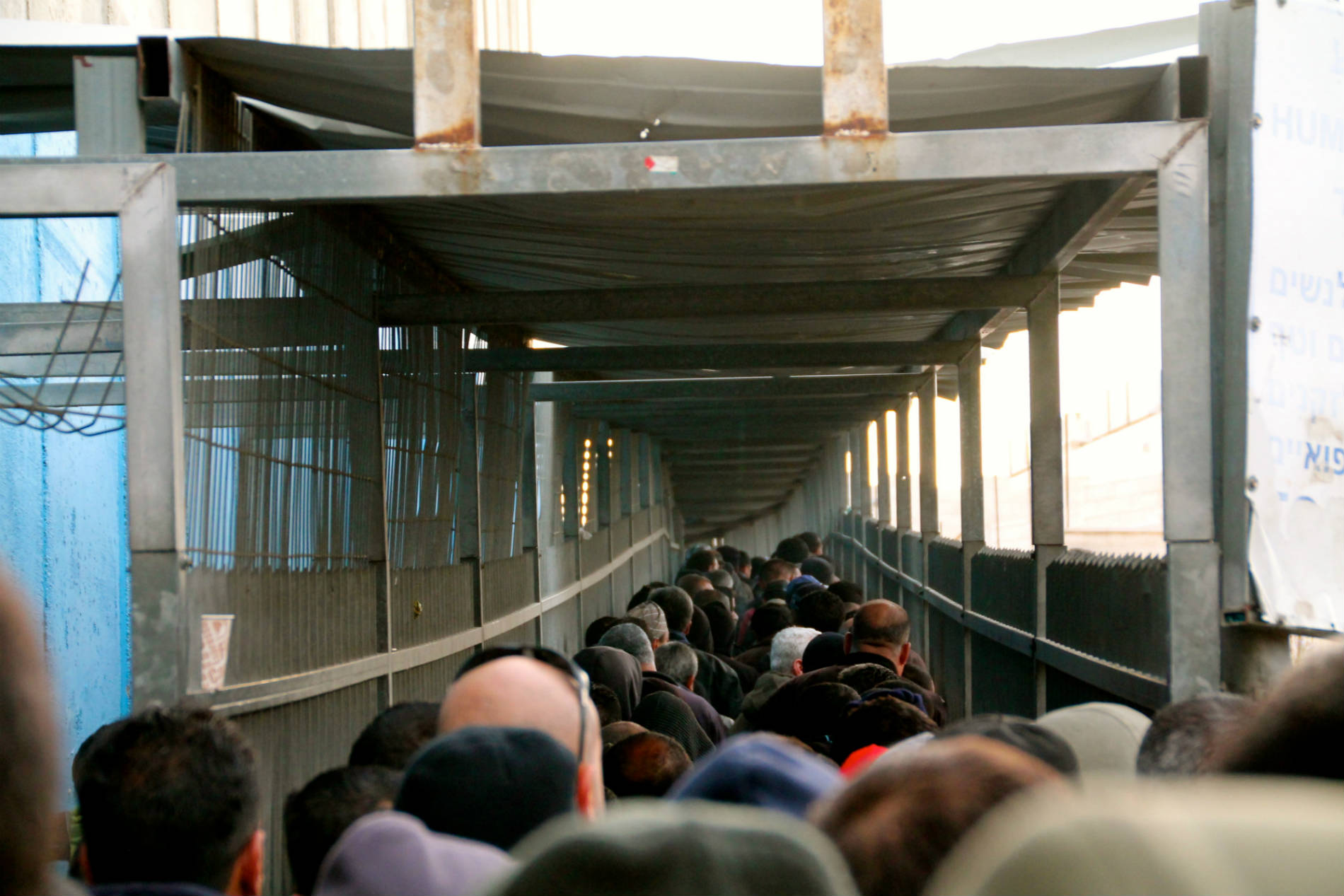
Bethlehem Checkpoint 300
Up to 6,000 people a day queue between 4-7am at Checkpoint 300 to get to their jobs in East Jerusalem and Israel. I’m there three times a week for three months and see that pushing, shouting and falling over is common and know that people have fainted due to the crush. The speed the queue moves depends on the military capacity on the day. The daily passage through one part of their occupied territory to another, through the airport style security of metal detectors, turnstiles and finger print technology while monitored by often aggressive, heavily armed soldiers and private security guards is the price some Palestinians have to pay to feed their families. Agencies have documented poor safety conditions and concerns of exploitation of the Palestinian workforce inside Israel but high unemployment rates in the West Bank and wages that are at least three times higher in Israel mean that these people consider themselves the lucky ones.
‘They are all brainwashed,’ says a volunteer from Machsom (checkpoint) Watch, an Israeli human rights organisation, when speaking about the attitude of soldiers and staff towards Palestinians at the checkpoint. ‘They were brought up to see them all as their enemies, as terrorists that kill people in the streets. He sits there and opposite him are people who are zero in his eyes. He doesn’t mind if this is an old person or woman or child or someone hurrying to work. He doesn’t see them.’
Some say this procedure is insignificant and that every country is entitled to protect its borders. But Checkpoint 300 is not on a ‘border’; it is 2km inside the Green Line, sitting deep inside Palestinian territory and illegal under International law.
Bethlehem is surrounded by a ring of ever expanding Israeli settlements and an 8 metre high concrete wall. Once a wealthy town, shops and restaurants stand forlorn and empty. Many original residents have migrated due to the economic pressures of living under occupation.
Bus loads of Christian tourists enter Bethlehem every day with many leaving within three hours of arriving. Depending on the tour operator, tourists can be forgiven for not realising that they have been driven through a checkpoint, past the Wall and that there are three overcrowded refugee camps dating back to 1950, which house over 20,000 refugees in cinder block structures in the city.
Two thirds of the camps’ residents are under eighteen and have grown up surrounded by guns, military vehicles and tear gas while separated from the rest of the world by walls, checkpoints and permits. The refugee camps have limited education and health facilities, rationed water and unemployment rates of 70%.
Hassan lives in one of the camps. At 14 years old he is a ball of energy with a brilliant smile. He wants to be an engineer when he is older. He finishes school every day at 12pm and while most kids his age are doing their homework, he sells drinks to people in the vehicle queue at the Bethlehem Checkpoint until late at night.
‘Good afternoon Madame. Holy water?’ he grins, while cheekily holding up a regular bottle of mineral water to the packed tourist buses. He generally gets a smile if not a sale.
‘The money is for the family, for the home, it’s not for me,’ he says when I ask him about his work. Hassan lives with his mother Shirin, and his brother and sister. Single mother Shirin works six days a week cleaning rooms in a local hotel. At just 35, she looks tired, ‘I want my kids to have a better life than me,’ she says.

Hassan’s school
Hassan attends a United Nations run school in the camp. It’s often closed due to military incursions as clashes develop regularly between the Israeli military and local youths. It’s not unusual to see boys breaking rocks into throw-able sized lumps and hurling them at the 10 metre high military watchtowers by slingshot or hand. On other days the military enter the camp on foot or in jeeps and for no apparent reason David and Goliath style scenes evolve as the two groups confront each other. People sometimes refer to the scenes as ‘a game of cat and mouse’ or ‘a drama’. The Israeli Army retaliate to stone throwing by using tear gas, stun grenades, rubber coated steel bullets and occasionally live ammunition.
I see tear gas canisters being fired into adjacent streets far away from the confrontations. I’m not surprised that Israeli human rights organisation B’Tselem has reported concerns on the Israeli military’s use of crowd control weapons and more recently Amnesty has called for a thorough investigation into the killing of two unarmed young men in demonstrations.
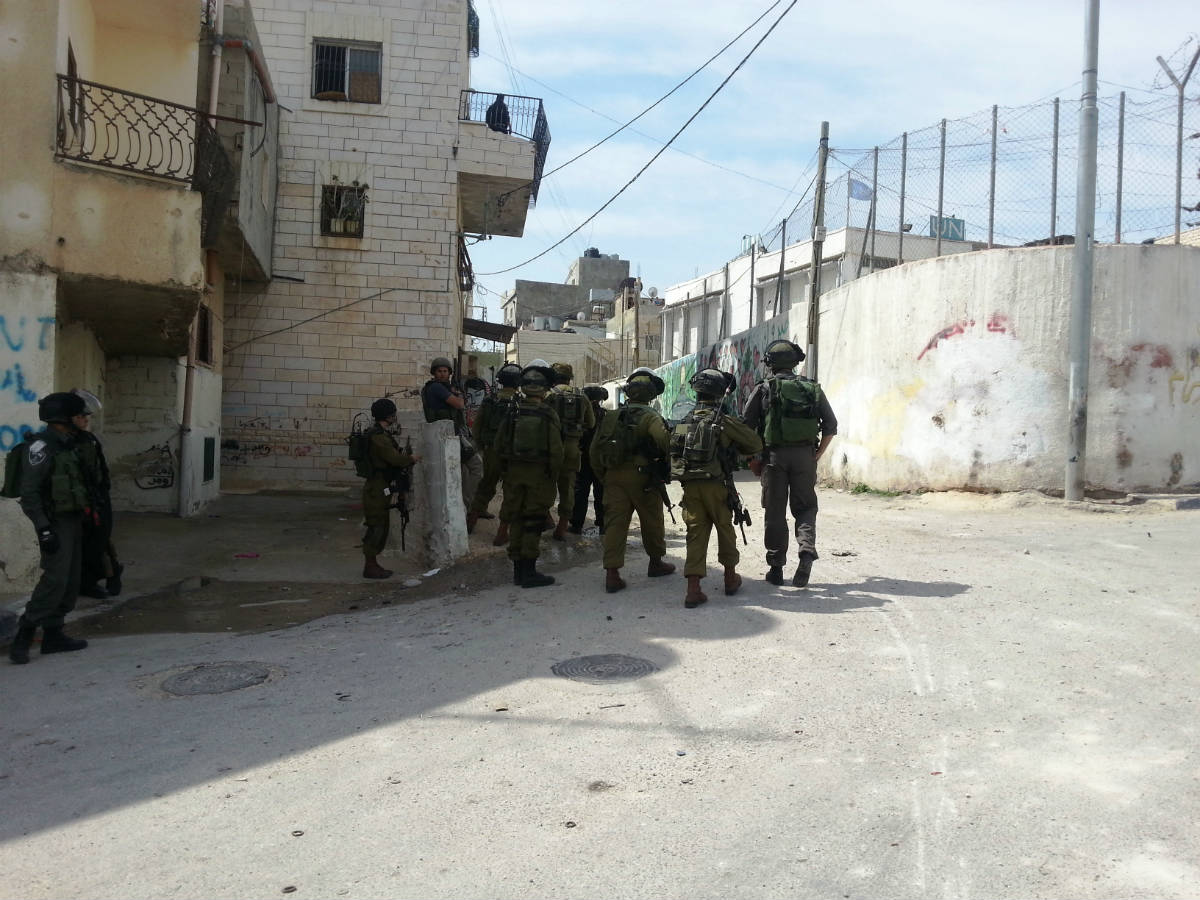
Military incursion into Aida camp
I sometimes run into Hassan during the clashes. He’s clutching a handful of tissues which he’s sprayed with his mother’s perfume. He gives them to me, ‘For you, for the gas,’ he says. Children in the West Bank have grown up with the smell of tear gas and it’s recommended to inhale a strong smell like an onion or menthol to counteract the effects.
Hassan takes me to his home one time. I’m invited for maqlouba, a traditional Bedouin dish with chicken, rice and vegetables. We have unreliable conversations using Google Translate and the family try to teach me the traditional line dance of Dabkeh. I say that I liked the smell of Shirin’s perfume on Hassan’s tissues and she gives me the bottle as a gift.
Like other boys his age, Hassan spends the evenings on social media. Most of the things he watches seem to be shaky mobile phone footage of violence, local army raids and people being injured. I ask him if he ever throws stones and he quickly shakes his head. He appears fearful of the military but I can’t help wonder how long this will last.
On a scorching hot day in the village of Beit Fajjar near Bethlehem, our group of human rights monitors from EAPPI sit on plastic chairs outside the home of an emotional man with tears in his eyes. He tells us about the arrest of his son. His wife stands quietly behind him and his other children look on.
His 15 year old son Ashraf was arrested the day before by the Israeli military. He has no idea why this has happened or where his son has been taken. Ashraf has been arrested with his friend, Farid who’s 13. Farid was on stomach medication after having two operations in the last year. He doesn’t have his tablets with him. The soldiers apparently arrested the boys on their way to the local school to play football.
A week later the families call us; the boys have been held in custody for eight days and then released in Jerusalem and left to find their own way home. They’re accused of setting fire to tyres which they both deny. On release they say they were made to sign papers. But nobody explained to them what they were signing. The boys couldn’t read the documents as they were written in Hebrew. The families have had to pay 1000 shekels (£200) for their release.
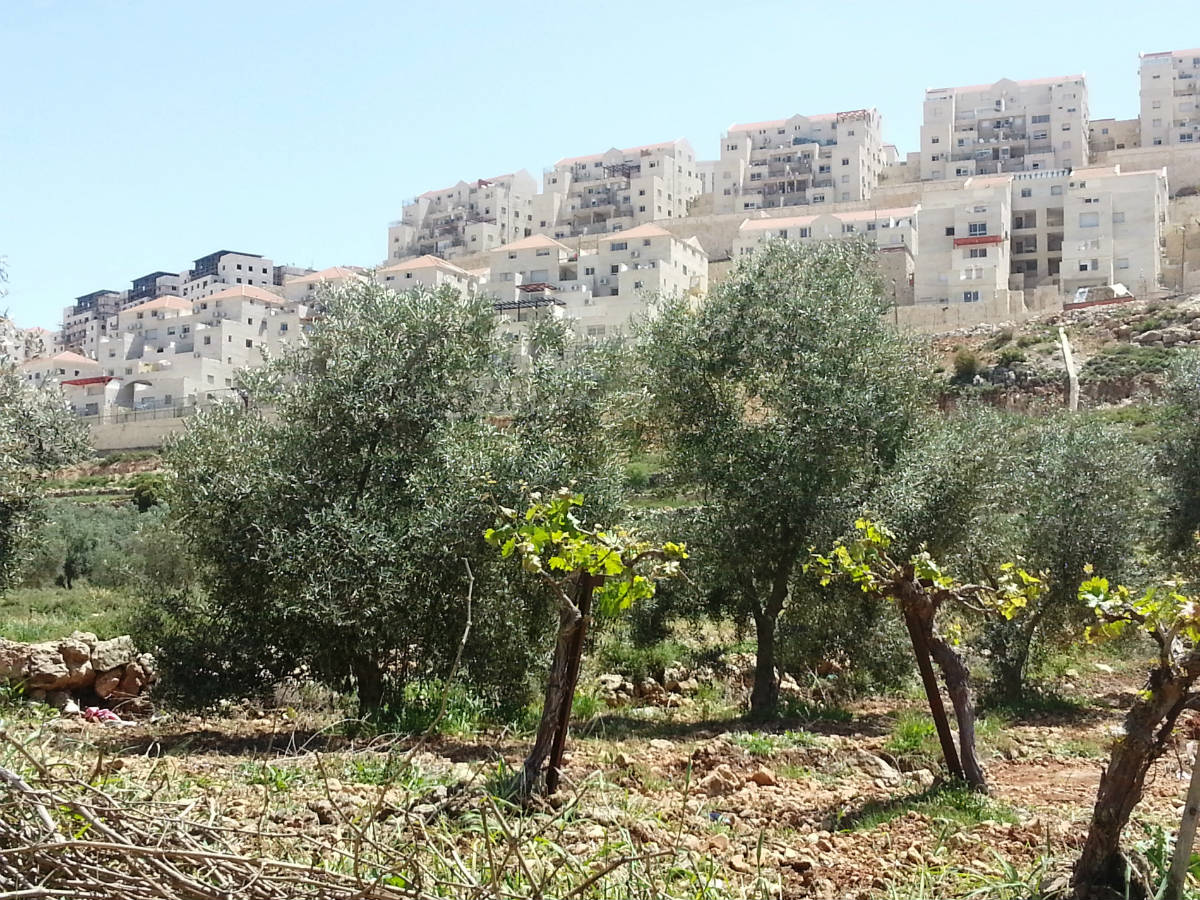
Beitar Illit and Wadi Fukin
We visit the boys separately after their release to ask them some questions about their treatment in custody. They don’t want to answer too many questions so we don’t push. Both appear anxious and subdued. Neither have returned to school since being arrested and the mother of the younger one says he won’t leave the house.
One morning I meet a group of journalists who have been called to report on the issues faced by the village of Al-Khader. A microcosm of the situation throughout Palestine, the village has been strangled by the Separation Barrier which has left thousands of acres of land on the Israeli side of the Wall.
On this particular day, a man begs the crowd of internationals for help through a microphone in a mixture of rage and tears. He says his home has been demolished three times already and he has just been issued another demolition order. His children look on, wide eyed and solemn as their father yells at us. As he speaks a huge crane is lowering another caravan onto an illegal Israeli outpost community on the hilltop behind him.
Another day: local farmers call in a panic asking us to come quickly with our cameras. We arrive to find the Israeli civil administration department confiscating 984 dunums (245 acres) of Palestinian land from three villages. I ask one man from the authorities what they are doing. He makes a call then says he’s not allowed to speak to me.
Seventy yellow signs are placed across the lands of the three villages which say, ‘State land. No trespassing.’ It’s one of the largest and most strategic land grabs in the south of the West Bank.The Palestinian owners of the land are given 45 days to submit petitions appealing against this.
There are dissenting voices on the Israeli side, people who are standing up against their country’s actions. One lives in an urban kibbutz in Southern Israel. Nomika Zion is one of the most extraordinary women I have ever met.
The town of Sderot is less than two miles away from Gaza and has been one of the targets of rocket fire since the beginning of the second intifada. Initially the rockets were more primitive and shorter range but over time have become more sophisticated. A petite person with a compelling message, Nomika talks fast at times, possibly the result of the years spent living on adrenalin. She describes what her life has been like living on one of the frontlines of the conflict.
‘Sometimes rockets came every day and sometimes less but it doesn’t matter because you have to be alert. It builds up. We used to sleep in the security room with our clothes on. There were 5 of us on mattresses, imagine what this does to a family.’
When the warning siren sounds in Sderot, people have up to fifteen seconds to get to a shelter. Each house has its own security room, the local school is built from reinforced concrete and the town is littered with bomb shelters decorated with colourful urban graffiti.
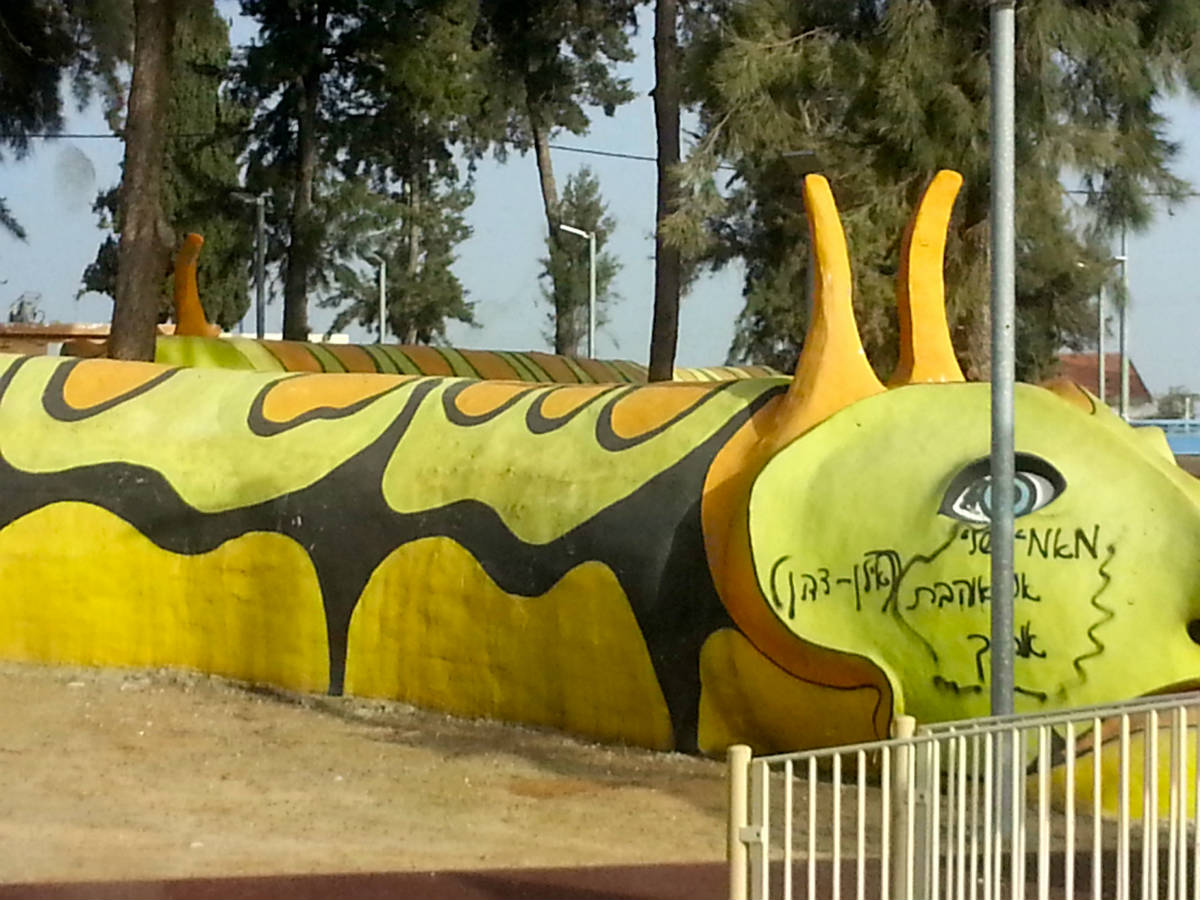
Bomb shelter in children’s playground
She tells us that most rockets will strike in the early morning when families are doing the school run. ‘You are in a van in the middle of the road with 7 or 8 children strapped in, including babies. The siren would sound. There is no way to undo all the seat belts in 10 seconds and we had to decide what to do. Whose child am I going to protect first?’ says Nomika.
In January 2008 when the town was being hit by 10 – 60 rockets a day, twenty people of different ages and backgrounds gathered to discuss their views and feelings and the peace initiative ‘Other Voice’ was born. ‘We refused to see them as our enemy, they are our neighbours who are just less than 2 miles away. We wanted to reach out and share our pain, our stories and empathise and open a human channel of communication,’ says Nomika.
The group made a connection with somebody in Gaza and over the months a network of connections was built. Members from the two communities met and organised events together until the blockade of Gaza began. ‘They risked their lives talking to us and some of them paid the price for talking to Israelis,’ she says.
Nomika describes her thoughts on her fellow Israelis: ‘We have lost our ability to see the other side, to see the Palestinians as human beings. First, you get blind, then numb and then you just don’t care anymore. It is a long process and we have lost our capacity to empathise. The Palestinians are invisible to the majority of Israeli society, they don’t have faces, voices, personal stories. The only identity they have is terrorist.’
In November 2008, Israel staged a raid on the Gaza strip which killed members of Hamas and saw an escalation in hostilities which culminated in ‘Operation Cast Lead’, a 22 day land and aerial bombardment on Gaza.
Nomika says, ‘The war had started, I call it a war. In Israeli society they call it an operation, I refuse to call it an operation. In Gaza it was a war.’ She talks of the natural tendency to take sides. ‘You are emotional, it is war, it is black and white,’ she says, ‘but it is much more complicated than that. The first group I cared about was my community. The second group I cared about were the Israeli soldiers. When they invaded I wondered who would come back, when and even if they are in one piece, how is their mind? The third group for me and more difficult to deal with were our friends from Gaza. We managed to communicate with some of them by text and email. It was cold, there was no electricity, thousands of buildings were demolished. When we lay in bed at night, our walls were shaking from the bombing. Almost everyone in Israel supported the war and I couldn’t cope with their voices anymore.’
The Palestinians are invisible to the majority of Israeli society, they don’t have faces, voices, personal stories.
Feeling increasingly isolated from her community and wanting to help, she stayed in her house for three weeks and wrote Not in my Name, a Sderot War Diary, which was later translated into twenty languages. She knew that she would be viewed as a traitor but was ready to pay the price of isolation as it helped her to deal with the glorification of war in her community. She describes a festival type atmosphere during ‘Cast Lead’ and tells us about people cheering and waving flags as they watched the bombs rain down on Gaza.
‘I couldn’t understand it,’ she says. ‘I feel like I live in a society that has developed an addiction to wars. I want to live in a healthy society. The people that want to build society on something different is getting smaller.’
Things change rapidly in Israel and Palestine. After my stay, Hamas and Fatah formed a unity government. The Pope visited and iconic photos of him praying at the wall in Bethlehem flooded the world media. Amnesty International issued a press release on ‘the routine use of excessive force and pattern of unlawful killings by the Israeli forces in the West Bank’ and my EAPPI colleagues continue to report daily on the repeated structural and bureaucratic violence towards the Palestinians.
Then came the tragic disappearance of three Israeli teenagers and the resulting collective punishment of hundreds of Palestinians associated with Hamas throughout the West Bank in ‘Operation Brother’s Keeper.’ An Israeli revenge attack resulted in the kidnap and brutal murder of 16 year old Palestinian Mohammed Abu Khader. Hamas rockets were fired from Gaza and the Israeli military launched ‘Operation Protective Edge’ which claimed over 2,100 lives, including 500 children. 64 Israeli soldiers were killed in the 50 day assault. Swathes of infrastructure were turned to rubble including UN schools, mosques, hospitals and Gaza’s only power station. Mass demonstrations took place all over the world protesting at the scale of the assault on, what is in effect, a captive population.
Whilst widely noted as symbolic, on October 13, British MPs voted overwhelmingly in favour of a motion calling on the government to recognise Palestine. Other European countries continue to follow suit against a backdrop of rising tensions and tit for tat violence in East Jerusalem. The regular announcements of further settlement expansion by Israel threaten any chance of a viable and contiguous ‘second state.’ Palestine sometimes feels like the only place in the world which is both appearing and disappearing at the same time.
